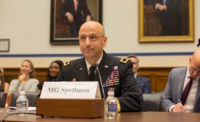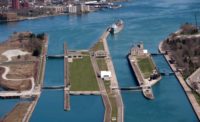A U.S. Army Corps of Engineers study has identified eight plans, costing as much as $18.4 billion, to block Asian carp and other harmful species from moving from the Mississippi River basin through waterways around Chicago and into the Great Lakes.
The Corps’ Great Lakes and Mississippi River Interbasin Study, released on Jan. 6, holds out the possibility of hundreds of billions of dollars in design and construction work over many years, but it does not pick a preferred plan from among the eight options, nor does it rank the proposals in priority order.
Thus, among the many uncertainties surrounding the program are which agency or agencies will pick a preferred option, when that selection will happen and what the choice will be. Another key question is where the funding will come from, once a plan is selected.
The eight alternatives’ costs range from a low of $68 million, for nonstructural controls such as netting and herbicides, to a high of $18.4 billion over 25 years.
That plan would include barriers at Chicago, Wilmette and Calumet City, Ill., and Hammond Ind., as well as treatment facilities at the three Illinois locations.
The plants would remove the targeted species using screening, filtration and ultraviolet light.
That $18.4-billion option also would include flood-risk management elements, including two reservoirs with total capacity of 20 billion gal. and four tunnels, totaling 39 mi. long.
The study was authorized in the 2007 Water Resources Development Act and modified in 2012's Moving Ahead for Progress in the 21st Century Act, or MAP-21. Dave Wethington, Corps project manager, told reporters in a conference call that the agency’s authorization from Congress requested that the report “provide a range of options and technologies” to block the fish and other species.
He also says that aquatic species control “is a shared responsibility” that requires a joint effort from state, local and federal government and input from the public.
Wethington says Corps ecosystem restoration projects traditionally carry a 65% federal-35% nonfederal cost split. But Congress must authorize such projects and then appropriate annual funding installments for them.





Post a comment to this article
Report Abusive Comment